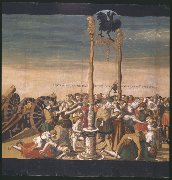Festivals Research Guide
A research guide focusing on documents of European festivals from the 16th through the early 20th century from the Festival collections of the Research Library at the Getty Research Institute.
Created 2000, updated 2004, with minor edits in 2010
Author: Marcia Reed, Head, Collection Development Research Library, Getty Research Institute
Created 2000, updated 2004, with minor edits in 2010
Author: Marcia Reed, Head, Collection Development Research Library, Getty Research Institute
Introduction

|
|
In European cities and courts, elaborate spectacles were staged to commemorate historic events, sacred feasts, and popular holidays. Royal birthdays, marriages, coronations, funerals, military triumphs, civic dates, and religious holidays were occasions for wealthy patrons to commission important, but temporary, works of art. Produced from ephemeral materials, these festival arts and decorations were significant projects in their time—as important as the surviving architecture and monuments in cities, or the paintings and sculptures now in museums. Although the original works do not survive, the art of festivals can be studied in archival documents and printed works that were made to plan and publicize these events. This digital resource presents a growing collection of original works on the historic, cultural, and socioeconomic context of European festivals, with special focus on visual documentation.
Feasts for the eye and sustenance for the body, ornate architecture and sculptures made of edible materials were significant aspects of festival celebrations. These elaborate banquets and displays of food as works of art were essential events in the festive progress from magnificent entry to final fireworks. Documentary records of court banquets and street festivals include small promotional publications (libretti) as well as illustrated festival books and single prints. Although early serving manuals and rare cookbooks can be seen as domestic science, in fact, they demonstrate how the lore of culinary history and its protocols enhances the iconography of art history, providing additional details on the symbolism of menus, seasonal ingredients, and table arrangements that elucidate the complex art and patronage of festivals.
Many of these works were shown in The Edible Monument: The Art of Food for Festivals exhibition, which was held at the Getty Research Institute from February 26 through May 21, 2000. This digitized library collection also incorporates works not in the exhibition.
Searching
To search the digitized collection select "View Digitized Works" at the top of the page. The collection may be searched using keywords for types of festivals, artists' and rulers' names, locations of festivals and other terms used to describe practices related to food presentation and table settings.

